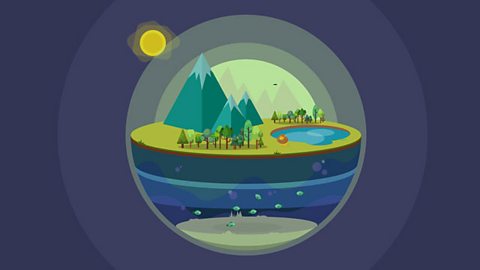What is wave energy?
Wave energy uses the power of the sea to generate electricity.
In this article you can learn:
- What causes waves
- What different devices have been invented to use wave energy
- What the advantages and disadvantages of wave energy are
This resource is suitable for energy and sustainability topics for primary school learners.
Video - What is wave energy?
In this video, learn how wave energy works to generate electricity and what the advantages and disadvantages of wave energy are.
Wave power is one of the newest types of renewable energy.
[Wavey waves at the camera]
Not that kind of wave! Poor lad…
That kind of wave.
As I was saying, wave power is pretty experimental.
In fact, he's a bit of an inventor aren’t you, Wavey?
He's making all kinds of new contraptions that harness the power of the waves.
But what causes waves?
Well, kinetic energy from the wind moves air across the sea.
The air drags along the surface, piling water up into ripples and waves. The stronger the wind, the bigger the wave.
And there's one place in Scotland that's particularly wave-tastic – The west coast of Orkney.
It's an awesome area for Wavey to test his contraptions.
First there's the attenuator – it looks a bit like a metal snake.
As the waves pass, each part moves separately, pushing and pulling pistons between them.
Then, there's the absorber – this can look a bit like a baby's dummy that's anchored to the seabed.
It bobs up and down on the surface and captures the energy of the rising and falling sea.
And finally, there's the oscillator - this looks a bit like a fan and moves back and forth with the underwater surge of the waves.
These machines capture kinetic energy from the waves in different ways.
But they all use that movement to turn a generator, which transforms kinetic energy into electricity.
And the bigger the waves, the more power Wavey's machines produce.
Which means that on calm days… Well, there's not a whole lot going on down on the wave farm.
No waves means no electricity.
Another disadvantage of wave-power is that wave machines can get in the way of fishing boat and spoil the view for tourists!
But on the plus side, Wavey is renewable, so he will never, ever run out and he's all around Scotland – all the time!
So you just keep on inventing, Wavey!
Where do waves come from?
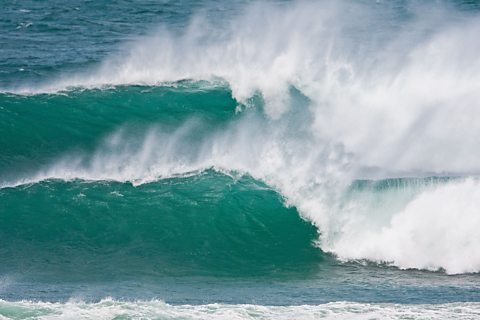
Most waves are caused by wind.
Wind is moving air. When it moves over water, frictionA force that makes it difficult for one object to move along the surface of another. from the air pulls on the surface of the water. This makes the water build up into ripples and waves.
The stronger the wind, the bigger the waves. Try blowing across a bowl or bath of water and see what waves you can make.

Wave energy in Orkney
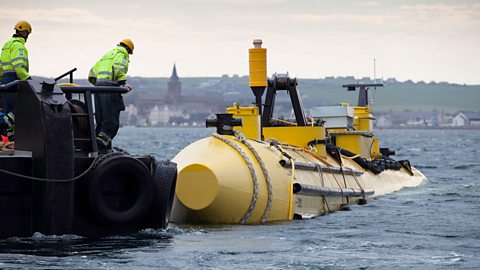
Wave energy technology is still being experimented on. People are trying to work out the best way to use waves to make electricity.
Lots of experiments into wave energy are carried out at the European Marine Energy Centre on Orkney. Orkney is exposed to high winds and large waves from the Atlantic Ocean, so it is a good place to test different wave energy machines.

What types of wave energy machines are there?
There are lots of different types of device to turn wave energy into electricity.
Three of the main types are called attenuators, absorbers and oscillator. Even though they look different, they all work on the same main idea.
The kinetic energyEnergy that an object possesses because of its movement. A ball being thrown through the air has kinetic energy because it is moving. When water moves this is also an example of kinetic energy. of the waves causes each machine to turn a generatorA machine that is used to make electricity. When the generator head is turned, this energy is converted to electrical energy. This generates electricity that is then passed through underwater cables to reach land and power homes and businesses. A collection of these wave machines is called a wave farm.
Look through the sideshow to find out how the different machines work.
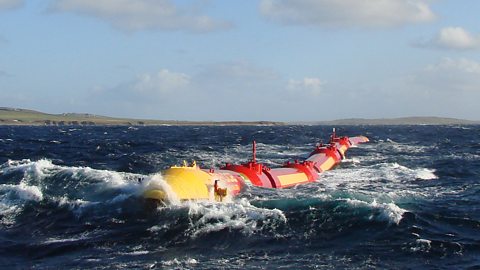
Image caption, Attenuator
An attenuator looks like a giant snake that floats on the surface of the water. It is made up of different parts that are joined together in a long line with its end facing into the waves. (Pelamis Wave Power)
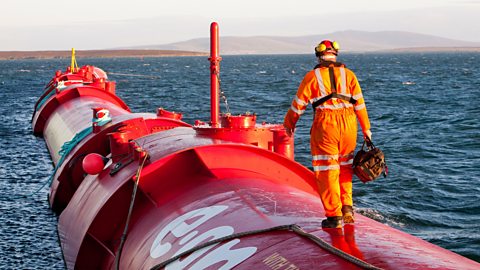
Image caption, Attenuator
Waves cause each part to move separately pushing and pulling pistons between them. The moving pistons turn a generator and this produces electricity. (Cavan Images / Alamy Stock Photo)
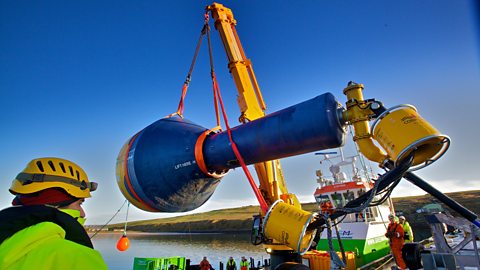
Image caption, Absorber
This is an absorber being lowered into the sea. It has a round floating top with a long shaft underneath that is anchored to the sea bed. (Colin Keldie)
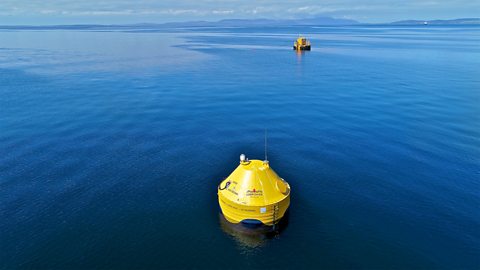
Image caption, Absorber
Waves make the floating top of the absorber bob up and down on the surface of the water. This pulls pistons up and down and these turn a generator that produces electricity. (Colin Keldie, courtesy of WES)
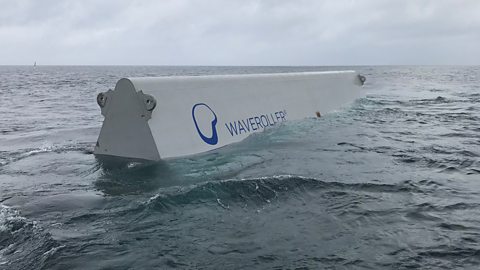
Image caption, Oscillator
At the surface of the sea, an oscillator looks like a long metal bar that moves back and forward with the passing waves. (Image of WaveRoller© courtesy of AW-Energy Oy)
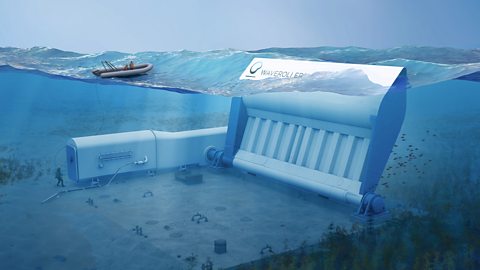
Image caption, Oscillator
This illustration shows that the oscillator looks like a giant fan with a hinge on the sea floor. Waves fan the oscillator back and forth. This movement turns a generator that produces electricity. (Image of WaveRoller© courtesy of AW-Energy Oy)
1 of 6
The advantages and disadvantages of wave energy
Advantages of wave energy
- Wave energy is renewable Something that does not run out when used. because we will never run out of wind or water.
- Wave energy is environmentally friendly as it doesn’t produce harmful gases while generating electricity.
- Scotland has many islands and is surrounded by the sea on three sides, so we have lots of access to waves.
Learn more about renewable energy here: What is renewable and non-renewable energy?
Disadvantages of wave energy
- Some people say these machines ruin the view of the sea.
- Wave energy can be unreliable. If there’s no wind, the waves aren’t big at all, meaning there is very little kinetic energy to convert into electricity.
- Wave farms can get in the way of fishing boats.

Key words about wave energy
Sorry, something went wrongCheck your connection, refresh the page and try again. – Energy that an object possesses because of its movement. A ball being thrown through the air has kinetic energy because it is moving. The kinetic energy of water, caused by the waves, causes the wave machines to move, turning the generator to create electricity.
Sorry, something went wrongCheck your connection, refresh the page and try again. – A machine that is used to make electricity. When the generator head is turned, this energy is converted to electrical energy.
Sorry, something went wrongCheck your connection, refresh the page and try again. – A collection of wind machines in the same location that are used to generate electricity through the power of the waves.
Sorry, something went wrongCheck your connection, refresh the page and try again. – Something that does not run out when used. There will always be waves that are caused by wind, which is what makes wave power a renewable source of energy.
Test your knowledge
Quiz
Challenge
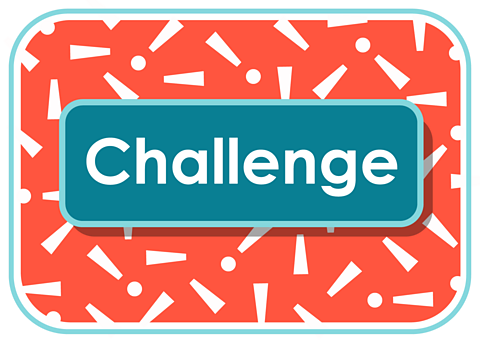
Write a short speech
Imagine you work for the Scottish Government and a wave energy company ask for some money to fund their latest experiments.
Write a short speech to explain your decision about whether to give them money and your reasons why.
Think about including some of the key words above and think about the advantages and disadvantages of wave energy to Scotland.
Here are some helpful guides on presenting and debating skills: Listening and talking
More on Sustainability
Find out more by working through a topic
- count24 of 28
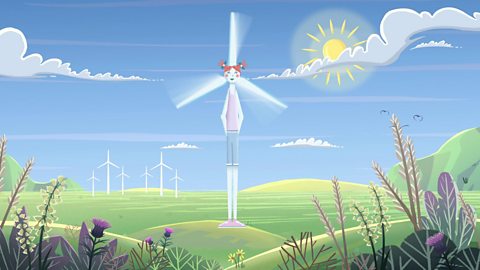
- count25 of 28
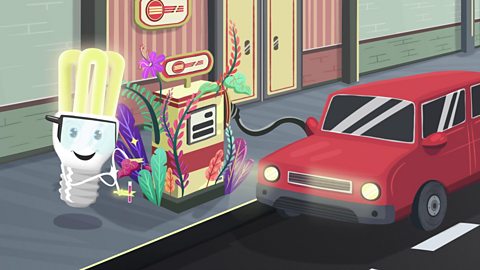
- count26 of 28

- count27 of 28
